|
Winter Finch Basics
Ron Pittaway |
|
|
|
Revised 20 September 2014. First published in
OFO NEWS in February 1998 |
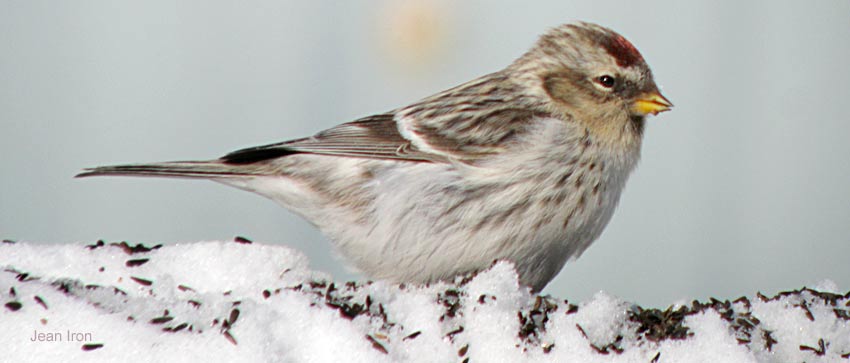 |
|
Hoary Redpoll at Norland, Ontario, 3
January 2008 |
|
|
|
Most winter finches are boreal species in the family Fringillidae noted
for their irruptive migrations in search of tree seed crops. They
feed almost entirely on seeds, supplemented with insects in summer.
Winter finches come readily to bird feeders where the two best seeds
to attract them are nyger and black oil sunflower seeds. Here, I
offer ideas about the comings and goings of 10 species of winter
finches in Ontario, including a comparison chart of finch species
and numbers from 38 Christmas Bird Counts (CBCs) in Algonquin Park. |
|
|
|
Pine Grosbeak
They have been recorded on 35 of 39 Algonquin CBCs, but they are
much less frequent on Toronto counts. Pine Grosbeaks are a
mountain-ash specialist. They irrupt into southern Ontario when
Showy Mountain-ash and American Mountain-ash berries are poor in the
boreal forest. Grosbeaks eat the seeds inside the berry, discarding
the flesh. They also eat the buds and seeds of hardwoods and
conifers. In settled areas, they feed on European Mountain-ash,
crabapples, sumac and visit bird feeders for sunflower seeds. Except
in irruption years, Pine Grosbeaks rarely occur in flocks of more
than 10 birds in southern Ontario. Larger flocks are seen in the
north. Bright rosy adult males are in the minority in most flocks.
First year males look like females, but some are distinctly
burnt-orange (instead of yellowish-olive to russet) on the crown and
rump, often with a splash of burnt-orange on the breast. They are
often tame and sit still for long periods, hence the name "Mope" in
Newfoundland. When excited, they flick their wings and tail. The
commonest call is a whistled tee-tee-teu. It is easily
imitated and will decoy them in closely, especially single birds.
Pine Grosbeaks migrate north earlier in spring than other finches,
usually leaving Algonquin by late March. |
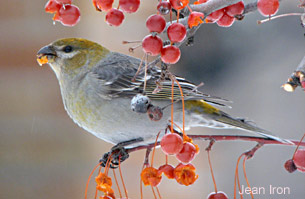
|
|
|
Female Pine Grosbeak |
|
|
|
|
Purple Finch
In most years, Purple Finches leave Ontario in the fall, returning in
mid-April to mid-May to breed. They have been recorded on 14 of 38
Algonquin Christmas Bird Counts. However, in years of bumper tree
seed crops, Purple Finches winter in Algonquin Park and regularly
farther north in numbers. These northerly wintering birds sometimes move south
in mid-February and March appearing suddenly at feeders in southern
Ontario when tree seeds farther north are exhausted. Purple Finches
give a distinctive metallic pink call that is easy to
recognize as they fly overhead.
Numbers dropped significantly in recent decades as spruce budworm
outbreaks subsided and currently a moderate population decline
continues in the province. An
easy way to tell Purple Finch from House Finch in all plumages is by
checking the tip of the tail - distinctly notched (slightly forked)
in Purple and squared off in House. |
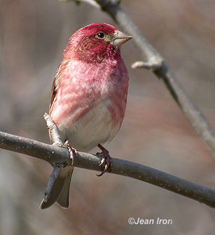 |
|
|
Male Purple Finch |
|
|
|
|
House Finch
Before 1940, House Finches did not occur in eastern North America.
Our birds are the descendants of caged birds from California that
were released by pet dealers in New York City to avoid raids by
wildlife officers. The first House Finch reported in Ontario was in
1970 and the first breeding was in 1978. House Finches, unlike other
winter finches, lack the ability to greatly increase their heat
production in the winter. Many House Finches migrate south in fall
and those that stay in very cold winters might not survive without
feeders. Numbers have declined in recent years, probably because of
the bacterial eye disease (Mycoplasma gallisepticum) now
frequent in the species. |

|
|
|
House Finch by Janice
Haines |
|
|
|
|
Red Crossbill
There are 10 call types of the Red Crossbill in North America that
may be separate or newly evolving species. They differ in size, bill
size/shape, coloration and cone preferences. In Ontario, at least three
(probably more) call types occur and breed from time to time. Most
types prefer pines, but Type 3 prefers Eastern Hemlock and White
Spruce. Type 2 is resident in small numbers in the extensive Eastern
White Pine forests of northeastern Algonquin Park. Another visiting
type prefers Red Pine forests. Type 3 occasionally wanders in large
numbers from the west to Ontario and breeds here. It is the smallest
Red Crossbill with the smallest bill, even smaller-billed than the
White-winged. Red Crossbills give hard jip-jip calls. The
song is a series of loud whistles and interspersed warbles, richer
and more varied than the White-winged Crossbill. Red Crossbills have
been recorded on 27 of 39 Algonquin CBCs. |
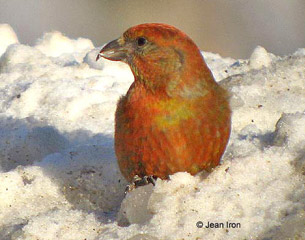
|
|
|
Male Red Crossbill |
|
|
|
|
White-winged Crossbill
Like a pendulum, White-winged Crossbills move back and forth across
the coniferous forests from Alaska to Newfoundland searching for
cone crops. The range of the White-winged Crossbill is much more
boreal than the Red Crossbill. The two species normally do not form
mixed flocks. Males usually are pinker than Red Crossbills. The
White-winged Crossbill's small bill is adapted to opening the small
cones of spruce and Tamarack. Black Spruce is a key winter
food in lean years because it has regular cone crops and usually some seeds are
held year-round in long lasting cones. White-wings sometimes feed in
hemlocks, but almost never in pines. When White Spruce cones are abundant
in Algonquin Park, White-winged Crossbills usually are common and
they are heard singing if they are going to nest. They have been
recorded on 33 of 38 Algonquin CBCs. The song is a long series of
loud canary-like trills on different pitches. They give a dry
strident cheet cheet calls. A distant flock sounds like
redpolls, but the notes are more rapid and often interspersed with a
diagnostic loud musical peet. Unlike the Red Crossbill, the
calls and appearance of the White-winged Crossbill are uniform
across the continent. |
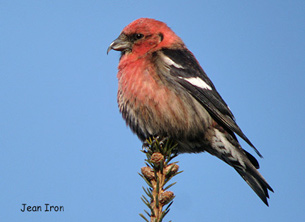
|
|
|
Male White-winged
Crossbill |
|
|
|
|
Common and Hoary Redpolls
Redpolls resemble siskins and
goldfinches in size, shape and habits. All these species often hang
upside down to feed. An occasional redpoll has an orange or yellow
"poll" (forehead). Common Redpolls are a White Birch specialist. White Birch
has good seed crops about every two years with some seed most years.
When birch catkins are loaded with seeds across the north, redpolls
remain in the boreal forest. They have been recorded on 32 of 38
Algonquin CBCs. In Algonquin, redpolls often feed high in White
Birch and Yellow Birch making it difficult to pick out a Hoary. In
settled areas, redpolls frequent ornamental birches, weedy fields
and feeders with nyger seed, making it easier to pick out a Hoary.
Both species give rattling chet-chet-chet. A distant flock
has a buzzing quality. The alarm call of perched birds is a loud
rising sweeEET like a goldfinch but coarser. During irruption
years, check flocks for the rare “Greater” Common Redpoll
(subspecies rostrata) from the High Arctic. It is reliably
identified by its larger size, darker and browner colour,
longer/thicker bill and longer tail in direct comparison to
“Southern” Common Redpolls (nominate flammea subspecies).
Most Hoaries are “Southern” Hoary Redpolls (subspecies exilipes).
The “Hornemann’s”Hoary Redpoll (nominate subspecies hornemanni)
from the High Arctic was previously regarded as a great rarity in
southern Canada and the northern United States. In recent decades a
number have been confirmed by photographs. Hornemann’s is most
reliably identified by its larger size in direct comparison to
flammea Common Redpoll or exilipes Hoary Redpoll. |
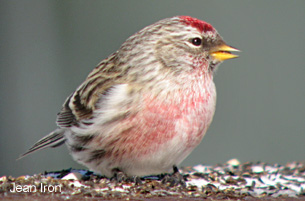
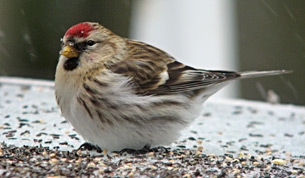 |
|
|
Common Redpolls |
|
|
|
|
Pine
Siskin
Like crossbills, siskins wander the continent in search of conifer
seeds. They forage less often on alder, birch and in weedy fields.
Most years the majority of siskins leave Ontario for the winter.
However, when spruces and other conifers are laden with cones,
siskins winter in large numbers. Recorded on 29 of 39 Algonquin CBCs,
high numbers of siskins in Algonquin Park occur about every five
years. Siskin flocks can be identified at a distance by their
distinctive flight formation. They swirl in tight compact flocks
whereas redpolls fly in loose undulating flocks. Through binoculars,
you can see flashes of yellow in their wings and tails. Siskins
silhouetted on top of a spruce can be identified by their very long
sharply pointed bills. Siskins give a wheezy clee-ip call
that is the best way to identify them in flight. Perched birds often
give a long rising buzzy shreeEEEE call that is unique. As
spring approaches, siskins are heard singing a twittering series of
husky and buzzy notes. They sometimes breed in March when snow still
covers the ground. At feeders, siskins relish nyger seeds. They are
aggressive, fighting with one another, goldfinches, redpolls and
even taking on Purple Finches. |

|
|
|
Pine Siskin |
|
|
|
|
American
Goldfinch
Now common in winter in southern Ontario, American Goldfinches were
once rare here in winter. The increase in wintering goldfinches is
linked to the tremendous rise in bird feeding. In winter,
goldfinches are inconspicuous and much less vocal than in summer,
usually giving only low te-te-te notes. The bright yellow
"Wild Canary" of summer disappears in winter because the adult males
molt into a female-like plumage. |
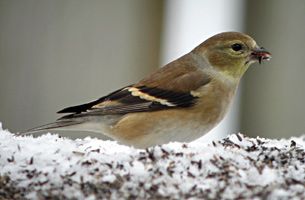 |
|
|
American Goldfinch |
|
|
|
|
Evening Grosbeak
This spectacular grosbeak was very rare
in Ontario 100 years ago. It now breeds here and is a regular but
uncommon winter finch in the province. Populations were very high
during the 1970s and 80s when spruce budworm outbreaks were at their
maximum across the boreal forest. The larvae are eaten by adults and
fed to young. It has been recorded on 34 of 39 Algonquin Christmas
Bird Counts. In Haliburton County where I live, the Evening Grosbeak
is called "Skidoo Bird" because the males are gold and black. In the
Ottawa area, they are known as "Greedies" because at feeders they
fight with one another and other birds while devouring millions of
sunflower seeds. Their loud ringing cleer and clee-ip
calls, sounding like glorified House Sparrows, are distinctive.
First year males are like adult males, but they can be separated at
close range by the blackish inner margins of their tertials. As with
other winter finches, the males tend to winter farther north than
females, which explains why many flocks have fewer males in the
south.
|
 |
|
|
Evening
Grosbeak |
|
|
|
Finch Facts
and Glossary |
|
Irruptions:
Boreal winter finches are noted for their erratic and nomadic
movements, here one winter and gone the next. Irruptions are
periodic mass movements to new areas, occasionally beyond their
normal ranges. Major irruptions are caused by tree crop failures and
usually coincide with high populations. There are two main types of
irruptions: one in fall and the other in late winter. Irrupting
finches search for areas where tree seeds are abundant and during
occasional "superflights" as in 1997-98, many species together go
well beyond their normal ranges. A second type of irruption happens
in late winter when tree seeds are exhausted in the north, often
forcing birds south to feeders. Do not confuse a late winter
movement from the north with a return flight from the south after a
fall irruption. Do two or more finch species synchronize their
irruptive movements? Algonquin Christmas Bird Count data suggest
that several boreal finches synchronize their movements and numbers
to a high degree most winters, but not every winter when some
species irrupt independently of one another. The variation is
probably because different tree species produce varying seed crops
from year to year and from place to place. All the boreal finches
sometimes irrupt together when there is a widespread failure of all
seed types. Continental climate is likely the common factor
affecting seed crops and synchronous movements in boreal finches.
Cone Crops:
Eastern White Pine has bumper cone crops every three to five years
(rarely two good crops in a row) with few cones in between. White
Spruce produces bumper crops every two to six
years with poor crops in between. Eastern Hemlock has good cone
crops about every second year. Good or poor seed crops are usually
widespread over hundreds of kilometres. Frequently several tree
species have bumper crops or crop failures the same year, helping to
synchronize finch movements and numbers. Refer to the 1994 finch
numbers in Algonquin when spruce, pine and hemlock crops cycled high
together. That 1994-95 winter, White-winged Crossbills fed on
spruce, Type 3 Red Crossbills and Pine Siskins fed on hemlock, but
redpolls were absent because White Birch seeds were abundant in the
boreal forest. Many factors affect seed crops; these include climate
warming, early
and late frosts, wet years, drought, insects and diseases. Flowering
and seed ripening must be synchronized with the yearly climatic
cycle. If the cycle is interrupted by unseasonable conditions, seed
production is reduced or aborted. This is why winter finches have adopted their
nomadic ways.
Finch Forecasting:
Knowledge of tree identification and seed crops will allow you to
make reasonable predictions about the upcoming winter and in some
cases the winter after. Tamarack, spruce, hemlock and cedar cones
mature in one season by mid-summer their crops are easily assessed.
Pine and birch allow you to predict seed crops for both the upcoming
winter and the following winter. White pine takes two seasons for
its cones to mature. By late summer of the first season, white pine
has 1-2 cm long conelets, which mature the next year in late summer.
Birches have two types of catkins: long slender pollen-filled male
catkins and conelike female seed catkins. Both types are normally
present on the trees and easy to see in fall and winter. The number
of seed catkins indicates how big the crop is this fall and winter and the
number of pollen catkins indicates the the probable size of the seed crop the
next winter.
Red-breasted
Nuthatch:
The
Red-breasted Nuthatch is a conifer seed specialist and it often
irrupts south as do the boreal finches. A cone crop failure is
indicated in those years that large numbers of Red-breasted
Nuthatches migrate south in late August and September. Similarly,
little or no southward movement indicates a good cone crop in the
north, particularly on white spruce. There is a strong correlation
between numbers (high and low) of Red-breasted Nuthatches and
White-winged Crossbills in Algonquin Park. Pine Siskin numbers are
moderately correlated with numbers of Red-breasted Nuthatches.
Mixed Flocks:
Winter finches (except the two redpolls) rarely form mixed flocks,
except at feeders and salted roads where they are drawn together.
However, lone individuals of one species may be with a large flock of a
related species.
Finch Calls:
Learn the distinctive calls of the winter finches as they are the
best way to identify them in flight.
Squeaking:
If you see or hear a flock of winter finches flying over, "squeak"
as loudly as you can. They will often turn around and perch in a
nearby tree.
Road
Kills:
Thousands of finches are killed by cars in some winters when they
seek the salt and sand put on roads. They have no fear of cars. If
you see finches on the road, slow down, flash the lights and tap the
horn. Be careful not to confuse other drivers.
Where
To See
Winter
Finches:
Algonquin Park is one of the best places in the world to see winter
finches, but some years are better than others depending on cone
crops. For the latest information on finches, call a park naturalist
at 613-637-2828.
Acknowledgements:
For
advice
and
helpful
comments
on
the original article in 1998,
I thank
Dennis
Barry,
Dan Brunton,
Margaret
Carney,
Bill
Crins,
Brenda
Chambers,
Al
Gordon,
Michel
Gosselin,
Peter Hynard,
Jean
Iron,
Chris
Lemieux,
Fred
Pinto,
Ron Scovell,
Ron
Tozer
and Mike
Turner. Jean Iron kindly formatted and commented on this revision. |
|
|
|
AIgonquin Park Christmas Bird Counts 1974 - 2013 |
|
|
|
|
1974 |
1975 |
1976 |
1977 |
1978 |
1979 |
1980 |
1981 |
1982 |
1983 |
1984 |
1985 |
|
Pine Grosbeak |
95 |
23 |
46 |
137 |
522 |
10 |
259 |
178 |
0 |
90 |
4 |
78 |
|
Purple Finch |
22 |
|
50 |
|
27 |
|
|
|
43 |
|
352 |
|
|
'Red
Crossbill |
22 |
|
5 |
|
20 |
|
421 |
|
8 |
|
431* |
13 |
|
White-winged
Crossbill |
562† |
7 |
5 |
325* |
641† |
50 |
1134†* |
14 |
1239†* |
|
8728†* |
|
|
Common Redpoll |
9 |
178 |
13 |
980 |
1971†* |
6 |
198 |
76 |
5 |
1 |
43 |
6 |
|
Pine Siskin |
1747†* |
|
29 |
192 |
1072 |
4 |
5 |
|
36 |
|
4264* |
|
|
American Goldfinch |
344 |
|
90 |
44 |
317 |
157 |
|
|
178 |
|
11 |
|
|
Evening Grosbeak |
691 |
|
56 |
|
69 |
413 |
83 |
1 |
1801†* |
4 |
1474†* |
|
|
Total Finches |
3602 |
208 |
244 |
1674 |
5262 |
682 |
1680 |
269 |
3310 |
95 |
15 |
307 |
|
|
Key to Symbols:
†
North American Highs, * Canadian Highs Data Courtesy of Ron
Tozer |
|
|
|
|
1986 |
1987 |
1988 |
1989 |
1990 |
1991 |
1992 |
1993 |
1994 |
1995 |
1996 |
1997 |
|
Pine Grosbeak |
95 |
161* |
4 |
192 |
9 |
150 |
8 |
24 |
4 |
129 |
0 |
116 |
|
Purple Finch |
|
|
|
|
|
3 |
125 |
|
154 |
|
57 |
|
|
'Red
Crossbill |
5 |
28 |
3 |
19 |
1 |
4 |
4 |
|
3527†* |
|
43 |
|
|
White-winged
Crossbill |
|
747 |
656 |
8092†* |
1 |
685 |
1435†* |
|
|
2490†* |
2 |
2848†* |
|
Common Redpoll |
1224# |
95 |
2 |
581 |
|
1773 |
|
20 |
|
58 |
|
207 |
|
Pine Siskin |
5 |
177 |
15 |
3862 |
|
22 |
261 |
|
4049†* |
10 |
255 |
|
|
American Goldfinch |
1 |
|
64 |
7 |
|
7 |
187 |
|
41 |
5 |
54 |
|
|
Evening Grosbeak |
16 |
147 |
288 |
137 |
21 |
217 |
291 |
21 |
91 |
1 |
504 |
5 |
|
Total Finches |
1346 |
1355 |
1032 |
12890 |
32 |
2861 |
2311 |
65 |
10356 |
205 |
3761 |
328 |
|
|
Key to Symbols:
†
North American Highs, * Canadian Highs |
|
|
|
|
1998 |
1999 |
2000 |
2001 |
2002 |
2003 |
2004 |
2005 |
2006 |
2007 |
2008 |
2009 |
2010 |
2011 |
2012 |
2013 |
|
Pine Grosbeak |
108 |
34 |
101 |
110 |
|
47 |
83 |
148 |
|
68 |
280 |
23 |
6 |
16 |
172 |
|
|
Purple Finch |
1189 |
|
5 |
1 |
959 |
|
|
|
280 |
|
|
|
|
26 |
|
321 |
|
'Red
Crossbill |
170 |
|
24 |
1 |
12 |
24 |
1 |
|
309 |
|
71 |
|
15 |
36 |
41 |
35 |
|
White-winged
Crossbill |
4150 |
5 |
2154 |
12 |
2060 |
149 |
1293 |
3 |
1513 |
|
1504 |
|
244 |
792 |
70 |
12 |
|
Common Redpoll |
174 |
11 |
3 |
65 |
|
217 |
304 |
30 |
1 |
23 |
1010 |
|
115 |
567 |
61 |
|
|
Pine Siskin |
624 |
|
1144 |
1 |
47 |
1 |
|
1 |
2325 |
|
135 |
1 |
1 |
836 |
1 |
|
|
American Goldfinch |
784 |
|
67 |
|
932 |
|
|
3 |
386 |
|
88 |
143 |
5 |
219 |
24 |
201 |
|
Evening Grosbeak |
219 |
5 |
110 |
1 |
96 |
|
2 |
1 |
119 |
|
24 |
3 |
1 |
80 |
6 |
73 |
|
Total Finches |
7418 |
55 |
3608 |
191 |
4106 |
438 |
1683 |
186 |
4933 |
91 |
3112 |
170 |
387 |
2572 |
375 |
642 |
|
|
Key to Symbols:
†
North American Highs, * Canadian Highs
Data from Birds of
Algonquin Park by Ron Tozer 2012 and 2013 Algonquin Park
Christmas Bird Count |
|
|
|
 |
|
Male Pine Grosbeak
eating crab apples near Toronto, 8 December 2007 |
|
|
|
|
|